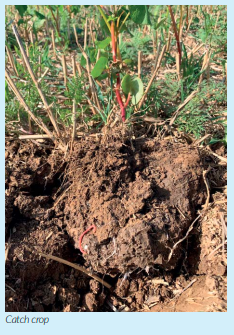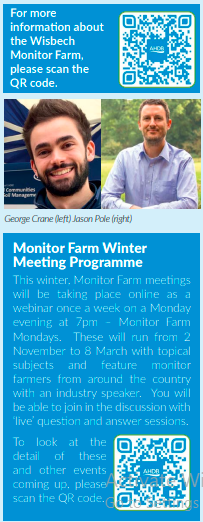
Andrew and Sam Melton, new to the AHDB Monitor Farm programme this year, are looking at how to make cover cropping and direct drilling work on their soils at Wisbech, Cambridgeshire.
Farming silty clay loam soils and with a keen interest in farming sustainably, whilst improving yields and productivity, Andrew and Sam Melton have kept a keen eye on the developments in cover cropping and direct drilling over the last few years. Seeing how other farms have made the successful transition to using cover crops and shallow tillage, Andrew and Sam, the father and son team, invested in a new direct drill (John Deere 750A) last season and are now interested in how to get optimum output from the drill, soil and the crop itself for their business.
The Melton’s farm 1,400 hectares of silty clay loam soils near Wisbech, Cambridgeshire. Their rotation includes wheat, barley, winter linseed, beans and sugar beet. The farm currently operates shallow tillage and full inversion cultivation systems, but have been looking at reducing soil tillage.
Joining the Monitor Farm programme in June 2020, one of the areas that Andrew and Sam are keen to focus on is incorporating cover cropping and reduced tillage into the rotation. To start on this journey, this autumn, the Melton’s are doing a try-out and testing three different cultivation methods:
1. Plough with a 7F Gregoire Besson
2. Shallow tillage using a Vaderstad Carrier with cross-cutter discs
3. Direct drilling with the John Deere 750A
The three systems have all been trialled alongside each other in a field, which was winter wheat last season. Following the combine, a catch crop (buckwheat, millet and sorghum) was established on some of the tramline plots but not where ploughed.
In addition, the shallow tillage area has a section with and without straw. Andrew is interested to test which of the systems works better for managing straw residue, something that he is keen to get right for optimum establishment.

In this way, one part has been chopped and the second section baled and removed. Measurements will be taken across the try-out areas through the season, including a look at soil (soil analysis, resistance, infiltration and structure), residue (levels left on the surface after drilling) and plant measurements (emergence, canopy cover, plant, tiller and ear counts, NDVI and yield).

The farm business also actively uses technology throughout all operations and to effectively manage fields and areas. As part of this try-out, fuel use and machinery telematics will be analysed to look at the impact of the different cultivation methods, alongside an analysis of the costs of using the different establishment systems. Building on previous farmer experiences, existing industry research on cover crops and now having the opportunity to try this on-farm, it is hoped that this will start to build a picture of how the Melton’s can best employ this system effectively for their business in the future.
Results will be shared in a future issue.
